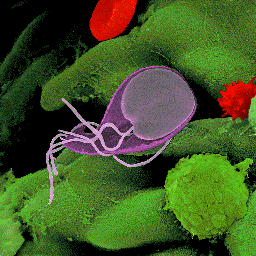Description and Size
Giardia
Giardia is a microscopic parasite that causes the diarrheal illness known as giardiasis. Giardia (also known as Giardia intestinalis, Giardia lamblia, or Giardia duodenalis) is found on surfaces or in soil, food, or water that has been contaminated with feces (poop) from infected humans or animals. Giardia is protected by an outer shell that allows it to survive outside the body for long periods of time and makes it tolerant to chlorine disinfection. While the parasite can be spread in different ways, water (drinking water and recreational water) is the most common mode of transmission.

Giardiasis is the most frequently diagnosed intestinal parasitic disease in the United States and among travelers with chronic diarrhea. Signs and symptoms may vary and can last for 1 to 2 weeks or longer. In some cases, people infected with Giardia have no symptoms. Acute symptoms include: diarrhea, gas, greasy stools that tend to float, stomach or abdominal cramps, upset stomach or nausea/vomiting, and dehydration (loss of fluids). Other, less common symptoms include itchy skin, hives, and swelling of the eye and joints. Sometimes, the symptoms of giardiasis might seem to resolve, only to come back again after several days or weeks. Giardiasis can cause weight loss and failure to absorb fat, lactose, vitamin A and vitamin B12. In children, severe giardiasis might delay physical and mental growth, slow development, and cause malnutrition
The size of the Giardia cyst is approximately 8 to 14 um; whereas, the Crytosporidium oocysts are usually 4 to 6 microns in diameter. (Note: 1 micron = 0.001 mm = 0.00004 inches ), which is too small to see with the naked eye.
Other Parasitic Flagellates
Trypanasoma brucei – Causes Sleeping Sickness
Trypanasoma cruzi Life Cycle – Causes Chagas’ Disease